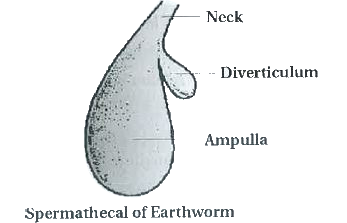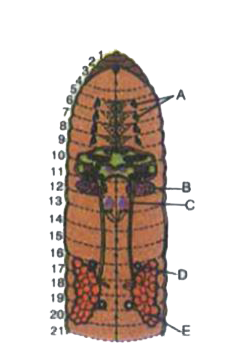Describe structure of reproductive system of earthworm with diagram.Solution in Gujrati
Earthworm is a hermaphrodite, i.e., testes and ovaries are present in the same animal. There are two pairs of testes present in the 10th and 11th segments. Their vasa deferentia run up to the 18th segment when they join the prostatic duct. Two pairs of accessory glands are present i.e. one pair of each in the 17th and 19th segments. The common prostrate and spermatic duct opens to the exterior by a pair of male genital pores on the ventrolateral side of the 18th segment. Four pairs of spermathecae are located in 6th - 9th segments (one pair in each segment). They receive and store spermatozoa during copulation.

One pair of ovaries is attached at the inter segmental septum of the 12lh and 13th segments. Ovarian funnels are present beneath the ovaries which continue into oviduct, join together and open on the ventral side as a single median female genital pore on the 14th segment. Mating : A mutual exchange of sperm occurs between two worms during mating. One worm has to find another worm and they mate juxtaposing opposite gonadal openings.The male genital pores of one comes in contact with pores of spermathecal of another earthworm. In this situations due to releasing of sperms, sperm cells enter in spermathecae of companion animal. Hence by doing exchange of sperm cells, companion animals separate from each other.

Formation of Cocoon : After sometime the glands of clitellum does secretion and make a white girdle like structure. Due to contraction, slowly girdle/ tube moves towards auterior end. The girdle moving towards anterior end when passes from spermathecae region, sperm cells stored in spermathecae enter in it. Now in this tube, egg cells of same animals and sperm cells of companion animal and nutrient fluid are collected. Both the ends of tube/ girdle came out of the body are closed. This tube is closed cocoon. Fertilization takes place in it and egg cells result in a zygote. .After about 3 weeks, each cocoon produces two to twenty baby earthworms. The development of earthworm is direct. It means no larvae formation takes place during development.
Topper's Solved these Questions
- STRUCTURAL ORGANISATION IN ANIMALSBOOK - KUMAR PRAKASHANCHAPTER - STRUCTURAL ORGANISATION IN ANIMALSEXERCISE - SECTION-B (Difference/Scientific Reason)
9 Videos
- STRUCTURAL ORGANISATION IN ANIMALSBOOK - KUMAR PRAKASHANCHAPTER - STRUCTURAL ORGANISATION IN ANIMALSEXERCISE - SECTION-C(DEFINITIONS /EXPLANATION-TERM/LOCATION-FUNCTION)
40 Videos
- SAMPLE QUESTION PAPER FOR SECOND EXAMBOOK - KUMAR PRAKASHANCHAPTER - SAMPLE QUESTION PAPER FOR SECOND EXAMEXERCISE - SECTION - D
1 Video
- THE LIVING WORLDBOOK - KUMAR PRAKASHANCHAPTER - THE LIVING WORLDEXERCISE - OBJECTIVE SECTION (FILL IN BLANKS)
9 Videos
Similar Questions
Simple Epithelium and Compound Epithelium
View SolutionLigaments
View SolutionExplain Double circulation with the help of chart.
View SolutionA .......... is a collection of pressed, dried and preserved plants mounted on ……..
View SolutionDescribe the structure of male reproductive system in human beings.
View SolutionIn the diagram of the reproductive system of earthworm A, B, C, D and E represent:

View SolutionDescribe the structure of human female reproductive system with a neat labelled diagram
View SolutionDescribe in brief the female reproductive system of human with diagram.
View SolutionDescribe human female reproductive system with labelled diagram.
View SolutionDescribe with diagram : Human - male reproductive system
View SolutionDescribe in brief the female reproductive system of human with diagram.
View SolutionDescribe with diagram, the female reproductive system of cockroach.
View Solution(earthworm)-Reproductive system(male&female) OF earthworm || Process OF Reproduction.
View SolutionDescribe the human female reproductive system with a labelled diagram .
View SolutionIn the diagram of the reproductive system of earthworm A, B, C, D and E represent

View Solution
